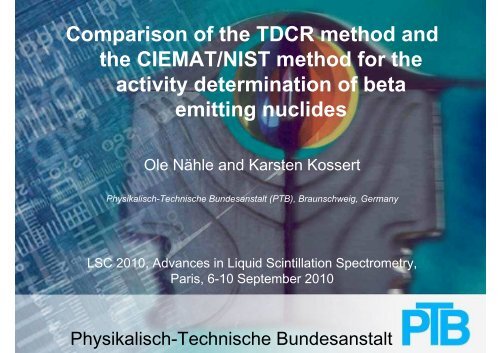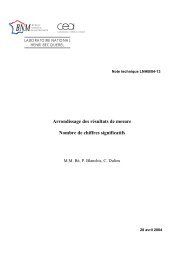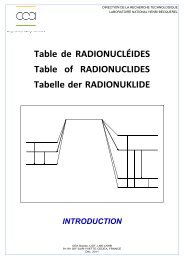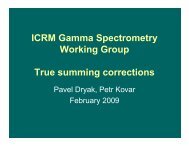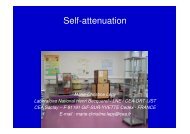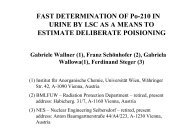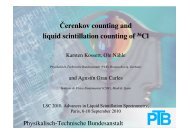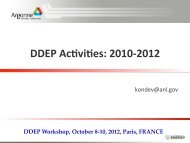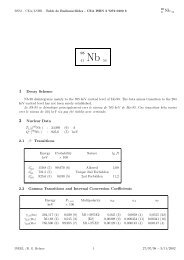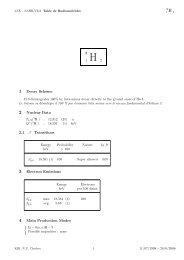Comparison of the TDCR method and the CIEMAT/NIST method for ...
Comparison of the TDCR method and the CIEMAT/NIST method for ...
Comparison of the TDCR method and the CIEMAT/NIST method for ...
Create successful ePaper yourself
Turn your PDF publications into a flip-book with our unique Google optimized e-Paper software.
<strong>Comparison</strong> <strong>of</strong> <strong>the</strong> <strong>TDCR</strong> <strong>method</strong> <strong>and</strong><br />
<strong>the</strong> <strong>CIEMAT</strong>/<strong>NIST</strong> <strong>method</strong> <strong>for</strong> <strong>the</strong><br />
activity determination <strong>of</strong> beta<br />
emitting nuclides<br />
Ole Nähle <strong>and</strong> Karsten Kossert<br />
Physikalisch-Technische Bundesanstalt (PTB), Braunschweig, Germany<br />
LSC 2010, Advances in Liquid Scintillation Spectrometry,<br />
Paris, 6-10 September 2010<br />
Physikalisch-Technische Bundesanstalt
Motivation<br />
• <strong>CIEMAT</strong>/<strong>NIST</strong> <strong>and</strong> <strong>TDCR</strong> are based on <strong>the</strong> same<br />
free parameter model<br />
• A systematic comparison is difficult (different<br />
counters, different s<strong>of</strong>tware, different parameters)<br />
• At PTB both <strong>method</strong>s are applied <strong>and</strong> <strong>the</strong> same<br />
s<strong>of</strong>tware routines are used<br />
• Pure β-emitters should be a simple test<br />
O. Nähle <strong>and</strong> K. Kossert <strong>Comparison</strong> <strong>of</strong> <strong>TDCR</strong> <strong>and</strong> CN <strong>for</strong> β emitters
Free parameter model<br />
Basic assumptions:<br />
• Statistical distribution <strong>of</strong> emitted photoelectrons at <strong>the</strong> photo cathode<br />
<strong>of</strong> <strong>the</strong> PMT (e.g. Poisson distribution):<br />
with<br />
P(<br />
x,<br />
m(<br />
E<br />
))<br />
x number <strong>of</strong> electrons<br />
E’ energy deposit in <strong>the</strong> scintillator<br />
m(E’) mean number <strong>of</strong> electrons<br />
• low PMT noise (coincidence circuit)<br />
m(<br />
E<br />
• threshold adjustment (single electron peak)<br />
'<br />
=<br />
) e<br />
x!<br />
x −m(<br />
E<br />
O. Nähle <strong>and</strong> K. Kossert <strong>Comparison</strong> <strong>of</strong> <strong>TDCR</strong> <strong>and</strong> CN <strong>for</strong> β emitters<br />
'<br />
'<br />
)
Counting efficiency<br />
ε =<br />
Free parameter model<br />
'<br />
1−<br />
P(<br />
0,<br />
m(<br />
E ) pq)<br />
= 1−<br />
e<br />
−m(<br />
E<br />
with<br />
m(E’)pq=EQ(E)/(nM)<br />
Q(E) non-linear response function <strong>of</strong> <strong>the</strong> scintillator<br />
M is a free parameter (sometimes called “figure<br />
<strong>of</strong> merit”); it corresponds to <strong>the</strong> average energy<br />
which is required to produce photoelectron<br />
1/M average number <strong>of</strong> photoelectrons per energy<br />
deposited in keV<br />
O. Nähle <strong>and</strong> K. Kossert <strong>Comparison</strong> <strong>of</strong> <strong>TDCR</strong> <strong>and</strong> CN <strong>for</strong> β emitters<br />
'<br />
) pq<br />
1<br />
E dE<br />
Q(E) =<br />
E ∫0 1 + k ⋅ dE / dx<br />
B
ε<br />
electron spectrum S(E)<br />
1 PMT:<br />
2 PMTs:<br />
3 PMTs:<br />
ε<br />
ε<br />
ε<br />
1<br />
2<br />
=<br />
=<br />
E<br />
max<br />
E<br />
Free parameter model<br />
= −<br />
∫<br />
0<br />
max<br />
∫<br />
0<br />
E<br />
max<br />
T ∫<br />
0<br />
−EQ(<br />
E)/ M<br />
SE ( )(1 e ) dE<br />
S(<br />
E)(<br />
1−<br />
e<br />
S(<br />
E)(<br />
1−<br />
−EQ(<br />
E)<br />
/ 2M<br />
logical sum <strong>of</strong> double coincidences in a system with 3 PMTs:<br />
O. Nähle <strong>and</strong> K. Kossert <strong>Comparison</strong> <strong>of</strong> <strong>TDCR</strong> <strong>and</strong> CN <strong>for</strong> β emitters<br />
e<br />
−EQ(<br />
E)<br />
/ 3<br />
M<br />
)<br />
)<br />
2<br />
3<br />
dE<br />
dE<br />
D =<br />
Emax<br />
∫<br />
0<br />
−EQ( E)/3M2 −EQ(<br />
E)/3M3 SE ( )(3(1 −e) −2(1 −e)<br />
) dE
<strong>CIEMAT</strong>/<strong>NIST</strong> <strong>method</strong> (2 PMTs):<br />
ε<br />
2<br />
=<br />
E<br />
max<br />
∫<br />
0<br />
S(<br />
E)(<br />
1−<br />
e<br />
Free parameter model<br />
−EQ(<br />
E)<br />
/ 2M<br />
The free parameter M is obtained from a measurement <strong>of</strong> a tracer<br />
radionuclide (e.g. 3H) under same experimental conditions. Usually<br />
external quenching indicators are used <strong>for</strong> <strong>the</strong> efficiency transfer.<br />
O. Nähle <strong>and</strong> K. Kossert <strong>Comparison</strong> <strong>of</strong> <strong>TDCR</strong> <strong>and</strong> CN <strong>for</strong> β emitters<br />
)<br />
2<br />
dE
<strong>TDCR</strong> <strong>method</strong> (3 PMTs):<br />
ε<br />
ε<br />
D<br />
=<br />
E<br />
max<br />
T ∫<br />
0<br />
E<br />
max<br />
= ∫ S(<br />
E)<br />
3((<br />
1−<br />
e<br />
0<br />
S(<br />
E)(<br />
1−<br />
e<br />
Free parameter model<br />
−EQ(<br />
E)<br />
/ 3M<br />
)<br />
−EQ(<br />
E)<br />
/ 3M<br />
2(<br />
1<br />
− e<br />
−EQ(<br />
E)<br />
/ 3M<br />
) dE<br />
The free parameter is derived from <strong>the</strong> ratio <strong>of</strong> <strong>the</strong> experimental<br />
counting rates<br />
3<br />
dE<br />
O. Nähle <strong>and</strong> K. Kossert <strong>Comparison</strong> <strong>of</strong> <strong>TDCR</strong> <strong>and</strong> CN <strong>for</strong> β emitters<br />
)<br />
2<br />
−<br />
RT<br />
εT<br />
<strong>TDCR</strong> = =<br />
R ε<br />
D D<br />
)<br />
3
Nuclides<br />
Radionuclides measured at PTB since 2002 using<br />
<strong>CIEMAT</strong>/<strong>NIST</strong> + … <strong>and</strong> <strong>CIEMAT</strong>/<strong>NIST</strong> + <strong>TDCR</strong> +<br />
…<br />
H-3, Be-10, C-14, F-18, Na-22, P-32, P-33, S-35,<br />
Cl-36, K-40, Ca-41, Ca-45, Cr-51, Mn-54, Fe-55,<br />
Co-58, Fe-59, Co-60, Ni-63, Cu-64, Zn-65, Ga-68,<br />
Ge-68/Ga-68, Se-79, Sr-85, Rb-87, Y-88, Sr-89, Sr-<br />
90/Y-90, Nb-93m, Zr-95, Tc-99, Cd-109, In-111, Sn-<br />
113, Cd-113m, In-114m,<br />
I-123, Sb-124, I-124, Sb-125, I-125, I-129, I-131,<br />
Cs-134, Cs-137, Ce-139, Ce-141, Pm-147, Sm-<br />
147, Ho-166m, Lu-176, Lu-177, Re-186, Ir-192, Tl-<br />
204, Po-208, Pb-210, Ac-227, Th-228, U-233, Np-<br />
O. Nähle <strong>and</strong> K. Kossert <strong>Comparison</strong> <strong>of</strong> <strong>TDCR</strong> <strong>and</strong> CN <strong>for</strong> β emitters
Experimental details<br />
• Sample composition: 15 mL Ultima Gold TM + 1 mL<br />
water, glass vials, quenching agent: nitromethane<br />
• Preparation by difference weighing <strong>of</strong> a pycnometer<br />
with traceable balances<br />
(typical mass <strong>of</strong> active solution: 30 mg)<br />
• Background sample was prepared with <strong>the</strong> same<br />
composition<br />
• Solutions were checked <strong>for</strong> impurities by means <strong>of</strong><br />
gamma-ray spectrometry <strong>and</strong> long-term LS<br />
measurements<br />
O. Nähle <strong>and</strong> K. Kossert <strong>Comparison</strong> <strong>of</strong> <strong>TDCR</strong> <strong>and</strong> CN <strong>for</strong> β emitters
Wallac 1414<br />
PerkinElmer TriCarb<br />
2800<br />
Crucial points<br />
• Threshhold adjustments<br />
• Features <strong>of</strong> signal processing<br />
• Anti-coincidence detectors<br />
Detectors: <strong>CIEMAT</strong>/<strong>NIST</strong><br />
• Coincidence logic is not transparent<br />
O. Nähle <strong>and</strong> K. Kossert <strong>Comparison</strong> <strong>of</strong> <strong>TDCR</strong> <strong>and</strong> CN <strong>for</strong> β emitters
Crucial points<br />
• Threshhold adjustments by user<br />
Detector: <strong>TDCR</strong><br />
• Coincidence <strong>and</strong> deadtime logic well known<br />
(MAC3)<br />
• No mass processing <strong>of</strong> samples<br />
O. Nähle <strong>and</strong> K. Kossert <strong>Comparison</strong> <strong>of</strong> <strong>TDCR</strong> <strong>and</strong> CN <strong>for</strong> β emitters
Nuclides <strong>and</strong> nuclear data (DDEP)<br />
Radionuclide<br />
Maximum<br />
energy in keV<br />
Nature<br />
Shape-factor<br />
function C(W)<br />
32P 1711 Allowed 1<br />
33P 249 Allowed 1<br />
35S 167 Allowed 1<br />
45Ca 256 Allowed 1<br />
63Ni 67 Allowed 1<br />
89Sr 1495<br />
1st <strong>for</strong>bidden<br />
unique<br />
p2 +q2 90Y 2280<br />
1st <strong>for</strong>bidden<br />
unique<br />
p2 +q2 99Tc 294 2nd <strong>for</strong>bidden 0.54·p2 +q2 147 Pm 225 1 st <strong>for</strong>bidden 1+0.3/W<br />
O. Nähle <strong>and</strong> K. Kossert <strong>Comparison</strong> <strong>of</strong> <strong>TDCR</strong> <strong>and</strong> CN <strong>for</strong> β emitters
counts in arbitrary units<br />
0.005<br />
0.004<br />
0.003<br />
0.002<br />
0.001<br />
0<br />
63Ni<br />
35S<br />
147Pm<br />
99Tc<br />
33P<br />
45<br />
Wallac counter with logarithmic amplification<br />
Analysis<br />
0 200 400 600 800 1000<br />
O. Nähle <strong>and</strong> K. Kossert <strong>Comparison</strong> <strong>of</strong> <strong>TDCR</strong> <strong>and</strong> CN <strong>for</strong> β emitters<br />
Ca<br />
89Sr<br />
32P<br />
90<br />
channel number<br />
Y
Uncertainty budget 33 P<br />
u(a)/a in %<br />
Component<br />
<strong>CIEMAT</strong>/<br />
<strong>NIST</strong><br />
<strong>TDCR</strong><br />
Statistics (6 samples; ≥ 8 repetitions per counter) 0.02 0.01<br />
Weighing 0.08 0.08<br />
Dead time 0.10 0.08<br />
Background 0.03 0.03<br />
Time <strong>of</strong> measurements (starting time <strong>and</strong> duration (lifetime))<br />
0.01 0.01<br />
Adsorption 0.05 0.05<br />
Radionuclide impurities (none detected) 0.05 0.05<br />
3H activity/<strong>TDCR</strong> value <strong>and</strong> fit 0.07 0.02<br />
Decay data (endpoint energy <strong>and</strong> beta shape-factor<br />
function)<br />
0.06 0.03<br />
Ionization quenching 0.20 0.17<br />
Quenching indicator (SQP(E), tSIE) 0.01 --<br />
Decay correction 0.13 0.10<br />
Square root <strong>of</strong> <strong>the</strong> sum <strong>of</strong> quadratic components 0.30 0.24<br />
O. Nähle <strong>and</strong> K. Kossert <strong>Comparison</strong> <strong>of</strong> <strong>TDCR</strong> <strong>and</strong> CN <strong>for</strong> β emitters
Analysis: Overall uncertainties<br />
Radionuclid<br />
e<br />
<strong>TDCR</strong> <strong>CIEMAT</strong>/<strong>NIST</strong> E β,max in<br />
keV<br />
u(a)/a in %<br />
90 Y 0.12 0.16 2280<br />
32 P 0.23 0.25 1711<br />
89 Sr 0.25 0.26 1495<br />
99 Tc 0.27 0.45 294<br />
45 Ca 0.25 0.27 256<br />
33 P 0.24 0.30 249<br />
147 Pm 0.35 0.35 225<br />
35 S 0.33 0.29 167<br />
63 Ni 0.97 0.58 67<br />
O. Nähle <strong>and</strong> K. Kossert <strong>Comparison</strong> <strong>of</strong> <strong>TDCR</strong> <strong>and</strong> CN <strong>for</strong> β emitters
Radionuclide<br />
90 Y<br />
32 P<br />
89 Sr<br />
99 Tc<br />
45 Ca<br />
33 P<br />
147 Pm<br />
35 S<br />
63 Ni<br />
kB in<br />
cm/MeV<br />
<strong>TDCR</strong><br />
a in kBq/g<br />
<strong>CIEMAT</strong>/<br />
<strong>NIST</strong><br />
(a <strong>TDCR</strong> -<br />
a CN )/a <strong>TDCR</strong> in %<br />
Analysis<br />
Unweighted<br />
mean activity<br />
a mean in kBq/g<br />
0.0075 191.93 191.96 -0.02 191.95<br />
0.0110 191.95 191.95 0.00 191.95<br />
0.0075 198.86 198.76 0.05 198.81<br />
0.0110 198.88 198.75 0.07 198.82<br />
0.0075 189.45 189.16 0.15 189.31<br />
0.0110 189.49 189.14 0.18 189.32<br />
0.0075 169.22 169.29 -0.04 169.26<br />
0.0110 169.46 169.16 0.18 169.31<br />
0.0075 182.65 182.45 0.11 182.55<br />
0.0110 182.97 182.23 0.40 182.60<br />
0.0075 243.40 243.55 -0.06 243.48<br />
0.0110 243.81 243.08 0.30 243.45<br />
0.0075 9.923 9.914 0.09 9.919<br />
0.0110 9.948 9.899 0.49 9.924<br />
0.0075 191.67 191.30 0.19 191.49<br />
0.0110 192.23 190.94 0.67 191.59<br />
0.0075 11.04 10.95 0.82 11.00<br />
0.0110 11.14 10.91 2.06 11.03<br />
O. Nähle <strong>and</strong> K. Kossert <strong>Comparison</strong> <strong>of</strong> <strong>TDCR</strong> <strong>and</strong> CN <strong>for</strong> β emitters
Radionuclide<br />
89 Sr<br />
63 Ni<br />
kB in<br />
cm/MeV<br />
<strong>TDCR</strong><br />
a in kBq/g<br />
Analysis: kB-value<br />
<strong>CIEMAT</strong>/<br />
<strong>NIST</strong><br />
(a <strong>TDCR</strong> -a CN )/a <strong>TDCR</strong><br />
in %<br />
Unweighted<br />
mean activity<br />
a mean in<br />
kBq/g<br />
0.0075 189.45 189.16 0.15 189.31<br />
0.0110 189.49 189.14 0.18 189.32<br />
0.0075 11.04 10.95 0.82 11.00<br />
0.0110 11.14 10.91 2.06 11.03<br />
• A change in kB-value has inverse effect <strong>for</strong> <strong>TDCR</strong> <strong>and</strong><br />
<strong>CIEMAT</strong>/<strong>NIST</strong><br />
• Unweighted mean is robust against changes in kB<br />
• Applying both <strong>method</strong>s <strong>the</strong> model dependence can be<br />
reduced<br />
• Our analyses seem to favour kB=0.0075 cm/MeV<br />
O. Nähle <strong>and</strong> K. Kossert <strong>Comparison</strong> <strong>of</strong> <strong>TDCR</strong> <strong>and</strong> CN <strong>for</strong> β emitters
Radionuclide<br />
Maximum<br />
Energy in keV<br />
• Changing C(W) to 1:<br />
Analysis: shape-factor<br />
Nature<br />
• <strong>TDCR</strong> result increases by 0.05%<br />
• <strong>CIEMAT</strong>/<strong>NIST</strong> increases by 0.95%<br />
Shape-factor<br />
function C(W)<br />
99 Tc 293.8(14) 2 nd <strong>for</strong>bidden 0.54·p 2 +q 2<br />
Reference<br />
Reich <strong>and</strong><br />
Schüpferling<br />
(1974)<br />
• No compensation but clear indication that C(W)=1 is not<br />
a suitable shape factor <strong>for</strong> 99 Tc<br />
O. Nähle <strong>and</strong> K. Kossert <strong>Comparison</strong> <strong>of</strong> <strong>TDCR</strong> <strong>and</strong> CN <strong>for</strong> β emitters
Summary <strong>and</strong> Outlook<br />
• A combination <strong>of</strong> <strong>TDCR</strong> <strong>and</strong> <strong>CIEMAT</strong> increases <strong>the</strong><br />
underst<strong>and</strong>ing <strong>of</strong> free parameter models<br />
• Systematic uncertainties may be identified <strong>and</strong><br />
partly cancel out<br />
• Tests with <strong>the</strong> Hidex <strong>TDCR</strong>-system are promising<br />
• Extend investigation to electron capture nuclides<br />
• Establish sample changer with γ-detector<br />
O. Nähle <strong>and</strong> K. Kossert <strong>Comparison</strong> <strong>of</strong> <strong>TDCR</strong> <strong>and</strong> CN <strong>for</strong> β emitters
<strong>TDCR</strong> sample changer<br />
Light-tight housing<br />
γ-Detector<br />
O. Nähle <strong>and</strong> K. Kossert <strong>Comparison</strong> <strong>of</strong> <strong>TDCR</strong> <strong>and</strong> CN <strong>for</strong> β emitters
Lead shield<br />
<strong>TDCR</strong> Sample changer<br />
Optical chamber Sample depot<br />
O. Nähle <strong>and</strong> K. Kossert <strong>Comparison</strong> <strong>of</strong> <strong>TDCR</strong> <strong>and</strong> CN <strong>for</strong> β emitters
Sample changer<br />
O. Nähle <strong>and</strong> K. Kossert <strong>Comparison</strong> <strong>of</strong> <strong>TDCR</strong> <strong>and</strong> CN <strong>for</strong> β emitters
Physikalisch-Technische Bundesanstalt<br />
<strong>TDCR</strong>
4π(LS)β−γ-Coincidence counting<br />
+ Sample<br />
changer<br />
Physikalisch-Technische Bundesanstalt
• A sample changer will be established soon<br />
Physikalisch-Technische Bundesanstalt<br />
Outlook<br />
• Versatile system including γ-channel (NaI or HPGe)<br />
• <strong>TDCR</strong> <strong>and</strong> coincidence counting with high sample<br />
statistics <strong>and</strong> repetitions<br />
• Taking <strong>TDCR</strong> <strong>and</strong> coincidence data simultaniously<br />
using FPGA-module
Thank you <strong>for</strong> your attention<br />
O. Nähle <strong>and</strong> K. Kossert <strong>Comparison</strong> <strong>of</strong> <strong>TDCR</strong> <strong>and</strong> CN <strong>for</strong> β emitters


